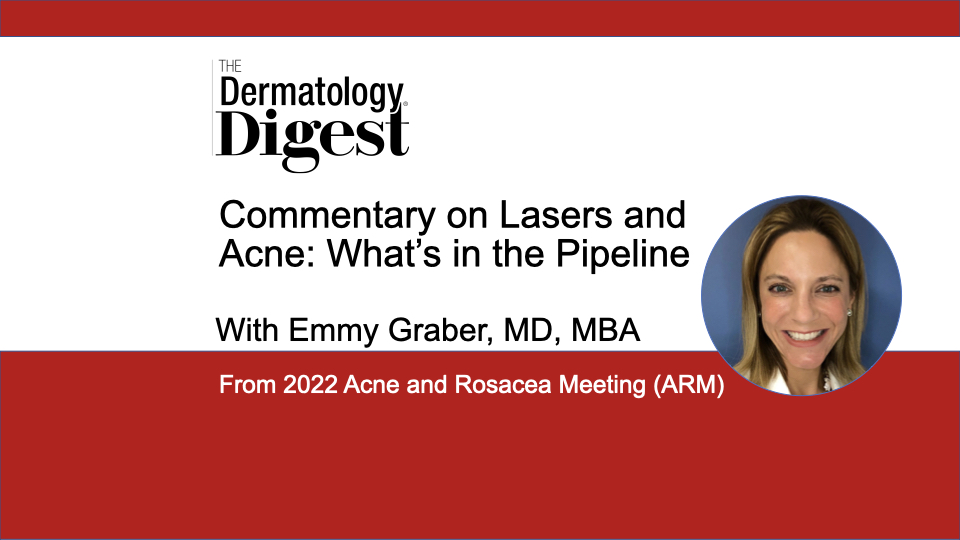Dr. Emmy Graber discusses three lasers that offer dermatologists an acne treatment alternative to creams and pills.
Emmy Graber, MD, MBA, is President, The Dermatology Institute of Boston, and Affiliate Clinical Instructor, Northeastern University, Boston, Massachusetts
“I was excited to give this talk because in the past I’ve given talks about acne and lasers and there really wasn’t much new to present. In the past year, this has really changed,” said Emmy Graber, MD, MBA, who presented “Lasers and Acne: What’s in the Pipeline,” at the 2022 Acne and Rosacea Meeting, held in partnership with the Cosmetic Bootcamp meeting in Aspen, Colorado.
Specifically, there are three categories of new and up-and-coming lasers for acne treatment, she said.
1. 1064 nm 650 Microsecond Laser
“The 1064 nm microsecond 650 microsecond laser is FDA-cleared for mild to moderate inflammatory acne. There have been some good results using multiple treatments with this laser.”
According to Dr. Graber, in a study of 20 subjects with moderate to severe acne who were randomized to receive 650 microsecond 1064 nm Nd:YAG laser or sham treatment, investigators found that IGA improved 26% in the laser group, compared to 7% in the sham group. Those who received laser treatment showed a 42% decrease in the number of inflammatory lesions compared with 26% in the sham group.1
2. 1726 nm Lasers
“The 1726 nm lasers are a completely novel wavelength for treating acne, and that’s why it’s so exciting.”
According to Dr. Graber, the 1726 nm wavelength directly targets sebum and, therefore, directly targets and kills the sebocytes in sebaceous glands.
“We are really getting to the root causes of acne that we can’t get to with any other wavelength.”
There are two 1726 nm wavelength laser devices. One is investigational in the U.S., but it is cleared for use in Europe. Studies are ongoing in the U.S., said Dr. Graber.
“There is a second 1726 nm laser that is FDA cleared. It is the AviClear (Cutera). It’s cleared for treating mild, moderate, and severe acne.”
Clinical studies done to get FDA approval for AviClear looked at a broad range of skin phototypes, she said.
“There were no adverse events such as hyperpigmentation or hypopigmentation in that clinical study of over 100 patients. Patients in that study did three treatments about a month apart and seemed to have a good, durable response, even at 6 months out and some beyond.”
The study also showed reduction in nodules, said Dr. Graber.
“There was about a 70% reduction in nodules using this 1726 nm laser at the 3-month follow up. And this is great because this kind of rivals the initial studies that were done looking at isotretinoin on nodules.”2
The AviClear data is courtesy of Cutera, with publication pending, she said.
3. Gold Microparticle With Laser
“The third category of lasers that I talked about in Aspen is a slightly older technology that is undergoing a relaunch. That is the gold microparticle plus laser treatment (formerly known as the Sebacia Laser Treatment).”
The combined gold particle and laser treatment is in the process of a relaunch in the U.S. and is expected to become available in the next few months, said Dr. Graber.
“This combines the use of topically applied gold microparticles plus use of a 1064 nm long-pulse laser to activate, if you will, the gold microparticles. At that wavelength the gold absorbs into the light and the light is converted into heat thus having a photothermal effect, which damages the sebaceous gland.”
Dr. Graber’s Choice
Dr. Graber said she has used the gold microparticles activated by the 1064 nm laser in the past but currently uses the FDA cleared 1726 nm laser AviClear by Cutera.
Notably, the 1726 nm laser can be used to treat mild, moderate, or severe acne and is safe for all skin types, said Dr. Graber.
“I really like it for patients who maybe aren’t getting the best results out of traditional therapies—from their topical creams or pills. It’s also good for patients who don’t want to use a pill or a cream and just want something different or something new.”
“Since we know it also significantly improves nodules, it can even be a wonderful option for an isotretinoin candidate who doesn’t want to take isotretinoin.”
Disclosure: Dr. Graber is a consultant with Cutera and Sebacia.
References
- Kesty K, Goldberg DJ. 650 usec 1064nm Nd:YAG laser treatment of acne: A double-blind randomized control study. J Cosmet Dermatol. 2020;19(9):2295-2300. doi:10.1111/jocd.13480.
- Strauss JS, Rapini RP, Shalita AR, et al. Isotretinoin therapy for acne: results of a multicenter dose-response study. J Am Acad Dermatol. 1984;10(3):490-496. doi:10.1016/s0190-9622(84)80100-0.

